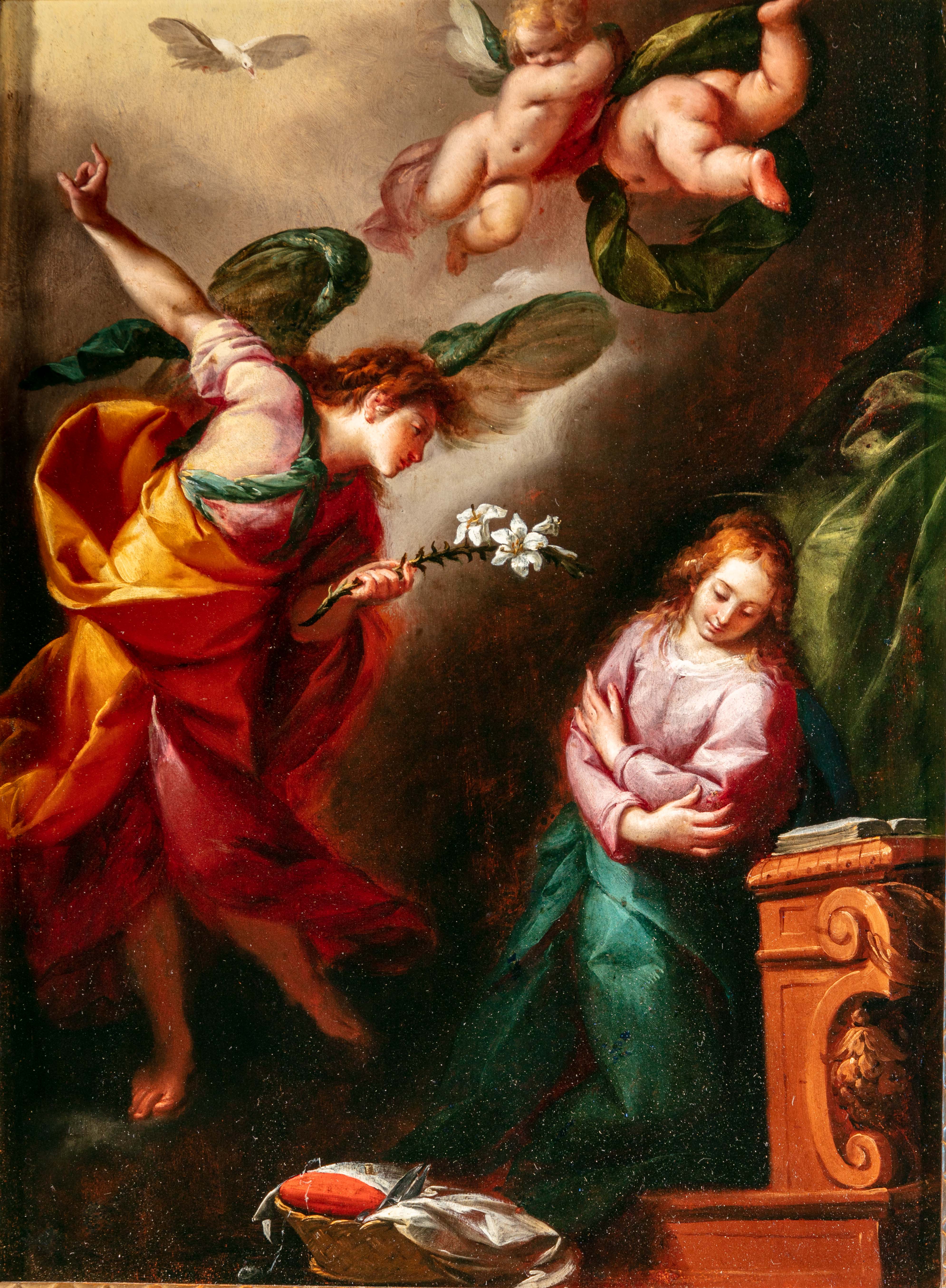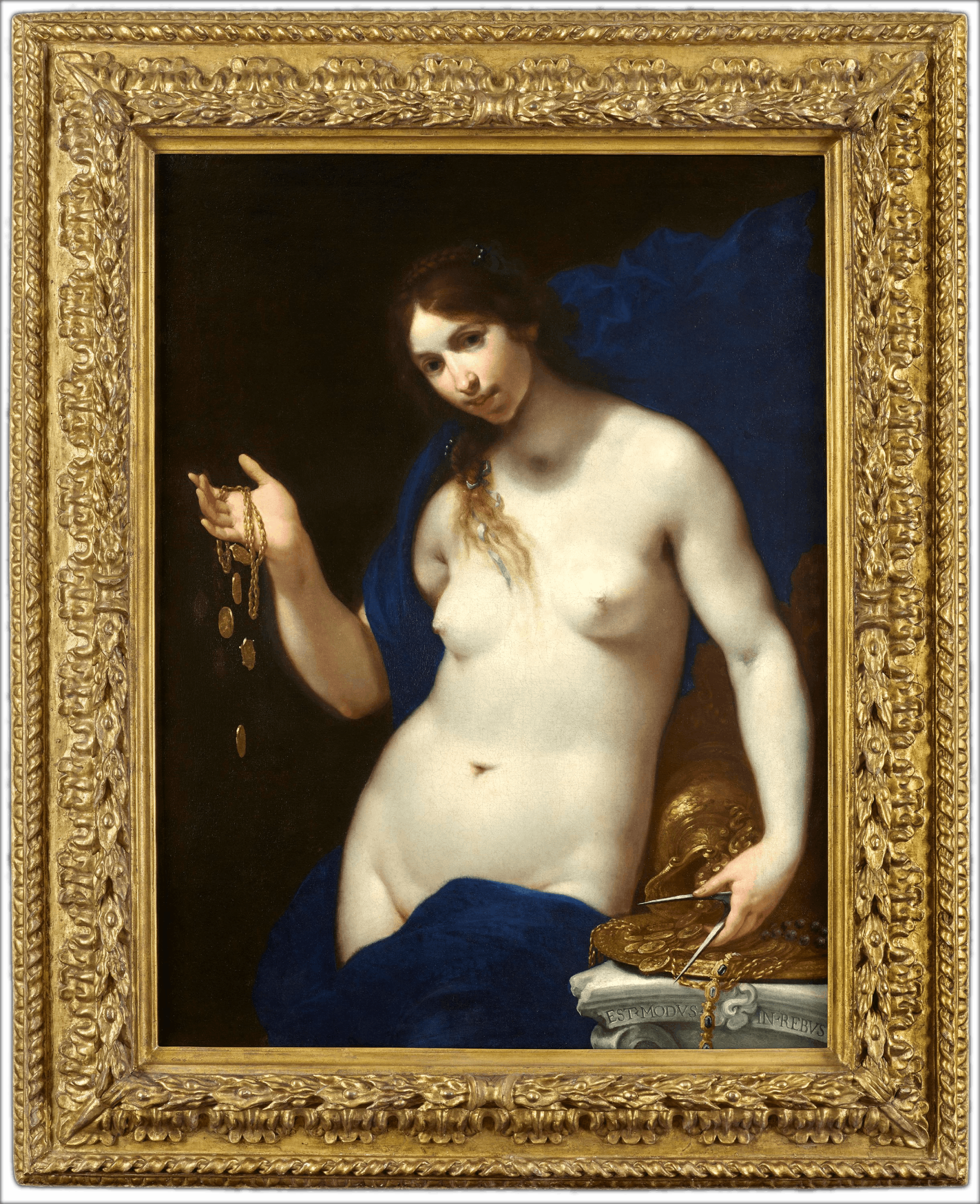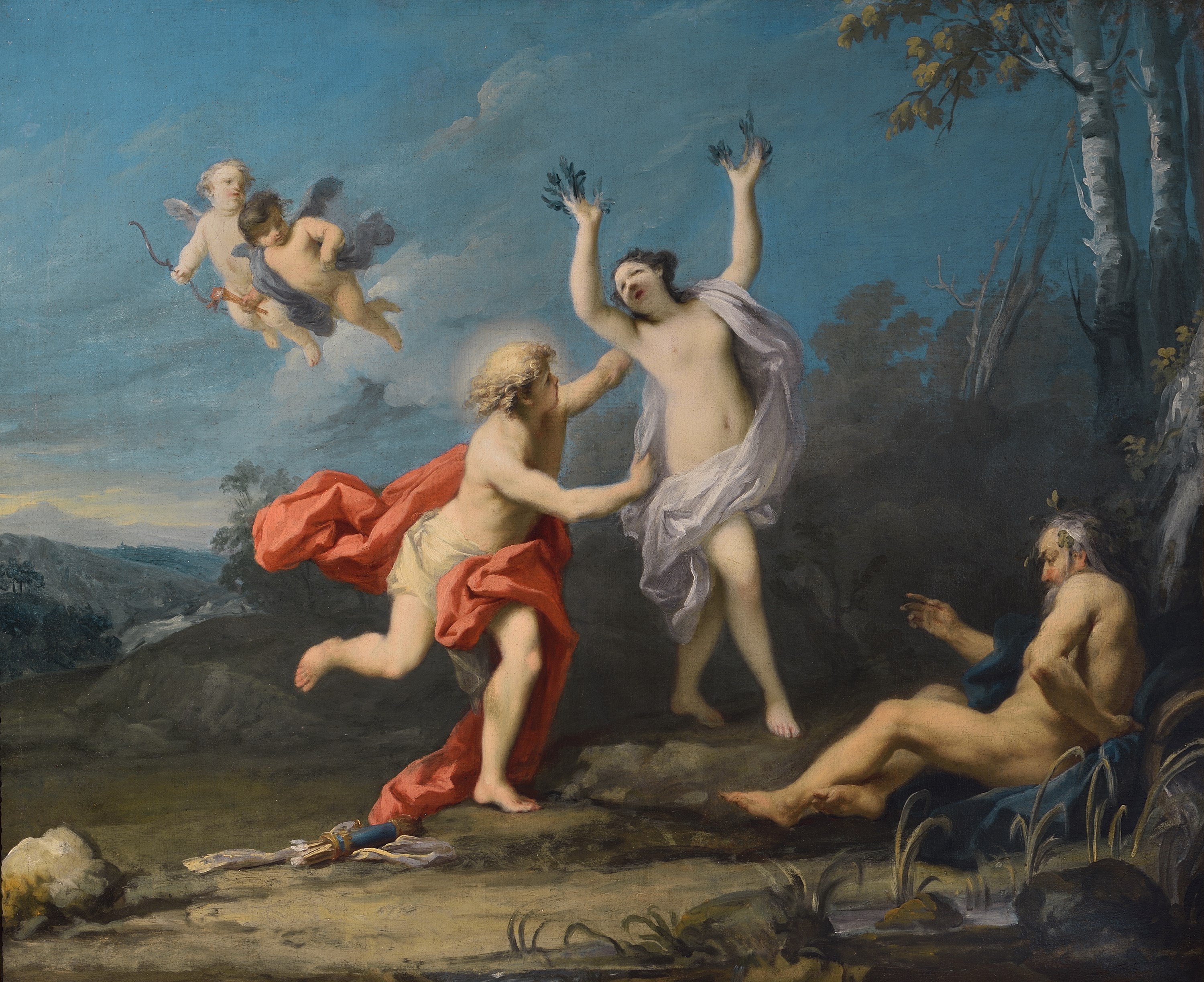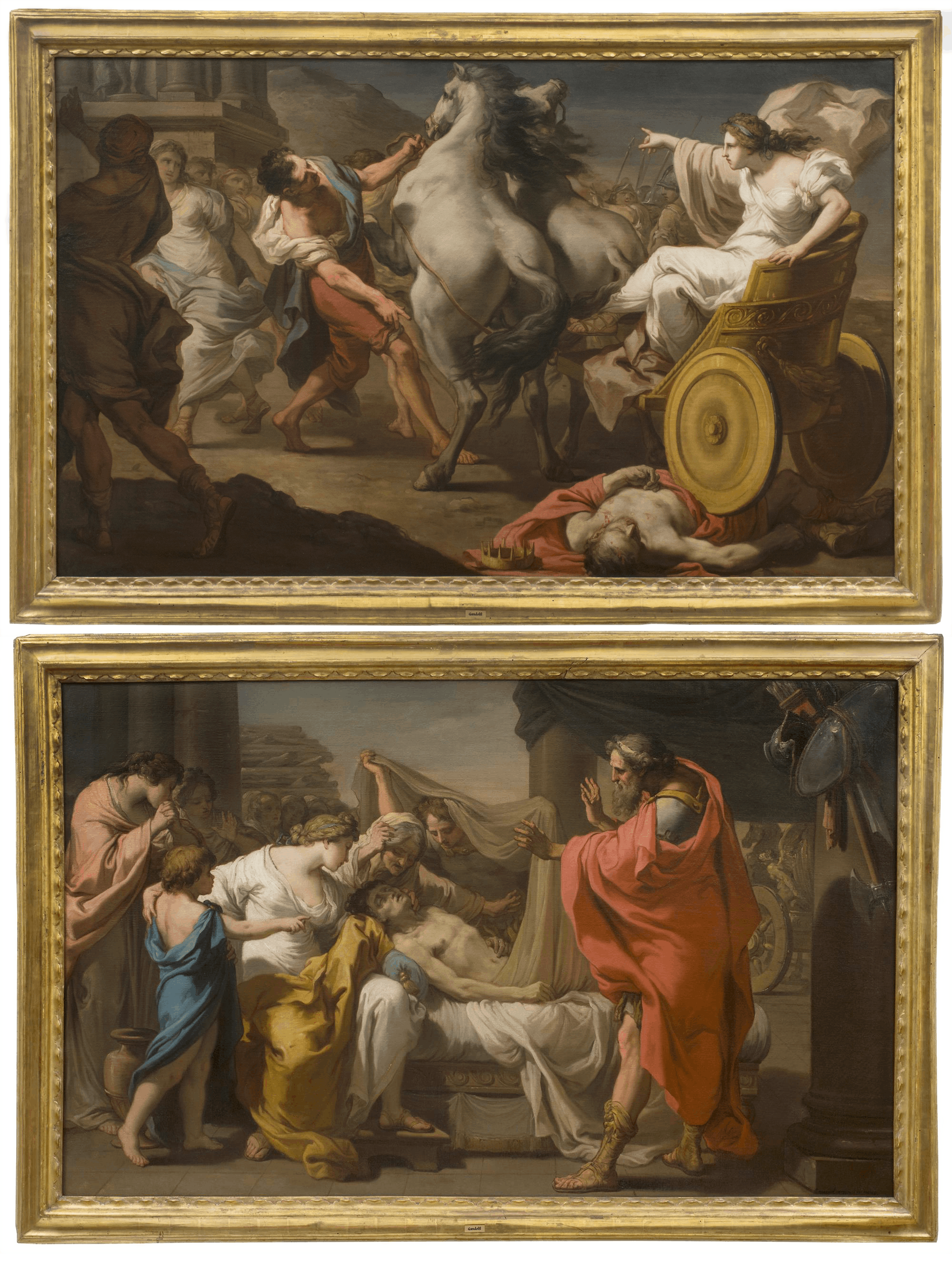Giovanni Francesco Barbieri, called Il Guercino
(Cento 1591 - Bologna 1666)
Saint Jerome in Prayer
Probably commissioned by Girolamo Panessi, Genoa, 1648;
or Camillo II or Alfonso II Gonzaga, Counts of Novellara, 1652
Private collection, Italy
...
N. Turner, The Paintings of Guercino: a revised and expanded catalogue raisonné, Rome, 2016, pp. 248-49, fig. 206 & pp. 547-48, no. 256.II
...
Standing out against a turbulent sky and a rocky landscape, Saint Jerome is portrayed half length, in the act of adoring a crucifix. His crimson-coloured cloak has slipped to the side, revealing a muscular torso, seemingly untouched by old age. Behind the saint sit an inkwell with a feather, propped on a shelf-like rock, and a book, presumably Jerome’s translation of the Bible (the so-ca ...
This painting, distinguished by a very high level of quality, was certainly executed by Giovanni Francesco Barbieri and can be dated on stylistic grounds to the end of the 1640s or the early 1650s, when the master from Cento was working in an increasingly elegant manner and with a lighter palette, influenced by the example of Guido Reni and Domenichino. In its refined choice of colours and sharp execution, our canvas is closely related to Guercino’s Lot and his Daughters, executed in 1650 for Girolamo Panessi (Gemäldegalerie, Dresden), or to his Vocation of Saint Aloysius Gonzaga painted in 1650–51 for the Theatine order at Guastalla (now Metropolitan Museum, New York). Both are also characterized, notwithstanding their differing original locations, by closely comparable lighting (see L. Salerno, I dipinti del Guercino, Rome, 1988, nos. 275 and 276 respectively).
These considerations indicate that, despite the recurrence of the present subject in Guercino’s Libro dei Conti, our painting is to be identified either with the “Saint Jerome half-length” for which the artist received payment from Girolamo Panessi 27 October 1648 or with one of the two “half-length figures”, including a Saint Jerome, for which the Count of Novellara paid Guercino, through Giovanni Battista Tartaglioni, on 29 November 1652 (see Il libro dei conti del Guercino, 1629–1666, ed. B. Ghelfi, Bologna, 1997, p. 140, no. 397, and p. 159, no. 462, respectively). Both works are yet to be identified with known paintings by the master and their descriptions closely match the present canvas.
The present composition was previously known through a version owned by the Museo di Capodimonte, currently in the Palazzo Reale in Naples, which can be attributed to Guercino’s workshop. Photographic comparison alone can reveal the superiority of the present canvas, which, also thanks to its excellent state of conservation, clearly displays the pictorial quality that the great master from Cento had developed in the course of his maturity. Treating a subject that he had already painted in his youth drove Guercino to seek new compositional solutions, which can be particularly appreciated in the emotional élan that pervades the image and in the vivid highlights that animate the palette.
The rediscovery of this painting constitutes an important addition to the established catalogue of works by Guercino, whose supreme mastery of expression is the cause of endless wonder.
Professor Daniele Benati
Bologna, 18 November 2016
Guercino – a short introduction to his life
Giovanni Francesco Barbieri was born in Cento, an early medieval town nestled in the countryside between Bologna and Ferrara, in 1591. According to the eighteenth-century biographer Giovanni Battista Passeri, whose 1772 Vite de’ pittori, scultori ed architetti offers a comprehensive if romanticized account of the painter’s life, Guercino’s father supplied wood to the celebrated Carracci workshop in Bologna, where the young Giovanni Francesco was supposedly first introduced to the art of painting by Annibale. Annibale had in point of fact left Bologna for Rome in 1595, when Guercino was only four years old, but Passeri’s anecdote certainly pinpoints one of the key influences of Guercino’s formative years. Indeed, the naturalistic, innovative style of the Carracci was to prove central to the development of our painter’s vocabulary. Ludovico Carracci was amongst the first to recognize the young artist’s talent, writing in 1617 that Guercino “has heroic quality… he paints with greatly felicitous invention. And [he is] a great draughtsman and very talented in the application of colour; he is a prodigy of nature and a miraculous surprise to those who see his works” ("si porta eroicamente... dipinge con somma felicità d'invenzione. E gran disegnatore e felicissimo coloritore; e mostro di natura e miracolo da far stupire chi vede le sue opere" quoted in G. Bottari-Ticozzi, Raccolta di lettere, Milan, 1822, I, pp. 286-289).
Other major sources of inspiration for Guercino were Bartolomeo Schedoni in Parma, Scarsellino in Ferrara and the sixteenth-century painters he admired on his first documented visit to Venice in 1618, above all Titian. Passeri also mentions an early encounter with Caravaggio in Rome, but this record appears unfounded, and the chiaroscuro gradations of Guercino’s early production derive rather from direct observation of Ludovico Carracci’s work. Our painter visited Rome, for the first time in 1621-23, at the behest of Pope Gregory XV. In 1642, following Guido Reni’s death, Guercino moved from Cento to Bologna, where he established a highly successful and prolific workshop and remained until his death in 1666.
Admired for his precocious talent from a young age, Guercino by 1617 presided over a workshop of no less than 23 pupils. His first patron, the canon Padre Antonio Mirandola, encouraged him to compose a volume of reference drawings for students of painting, which was published in 1619 under the title Primi elementi per introdurre i Giovani al Disegno, with a dedication to the Gonzaga Duke of Mantua, who expressed his appreciation by gifting 100 scudi to the painter and by commissioning from him a picture with a subject of his choice. Pleased with the result, a representation of Erminia and the Shepherds, the Duke duly knighted the young artist.
The early years of Guercino’s production – before his journey to Rome – were dominated by a series of commissions in his native Emilia Romagna region, notably for the influential Pepoli family in Bologna, for Alessandro Ludovisi, the city’s Archbishop and future Pope Gregory XV, and for the papal legate in Ferrara, Cardinal Iacopo Serra. The bold and deep colouring, dramatic shadowing, heightened representation of emotions and vigorous, charged brushstrokes of this period would gradually mature into more classicizing and luminous compositions as a result of Guercino’s seminal years in Rome.
According to the writings of Malvasia, Guercino began work at the Vatican in May 1621, tasked with decorating the Loggia delle Benedizioni. Though he never completed it, Guercino was far from idle in Rome. Most notably he executed the fresco of Aurora for the ceiling of the Villa Ludovisi’s ground-floor salon and created the immense Burial of Saint Petronilla altarpiece for the Basilica of Saint Peter’s. For Cardinal Scipione Borghese Guercino painted Saint Chrysogonus in Glory for the ceiling of the church of Saint Chrysogonus in Trastevere, and for the Patrizi family’s palace (now Costaguti) he frescoed a representation of the chariot of Armida. In Rome Guercino was able to observe the mastery both of his predecessors, from Raphael to Michelangelo, and of his contemporaries, such as Guido Reni and Domenichino, whose clearer, more fluid palettes and echoes of classical antiquity made a profound impression on our painter.
Upon his return to Cento in 1623 Guercino set out to resume the local commissions he had interrupted owning to his Roman sojourn, but by this time his fame was such that patrons sought him out from all corners of the Italian peninsula and beyond. Indeed it is said that when Queen Catherine of Sweden paid him a visit she asked permission to touch the hand that had created such marvels in paint, and both Charles I of England and the King of France offered him the coveted position of court painter, both of which he refused. Guercino eventually left Cento in 164? to settle in Bologna, where during the later phase of his career, lasting over twenty years, he was consecrated as one of the greatest painters of the seventeenth century.
Starting in Rome, Guercino’s style had begun to developed from the more exuberant, naturalistic language of his youth to a subtler, more idealizing and distilled one. The vigorous dynamism of his early figures evolved into more sensitively composed arrangements, and the relentless chiaroscuro light he had inherited from the Venetian Cinquecento and Ludovico Carracci transformed into a softer, warmer glow. Physiognomies changed too, as the more rustic traits of his characters were tempered by the influence of Rome’s classicizing idealism. This evolution is beautifully exemplified by works such as the present canvas, where the figure of Saint Jerome emerges from a dark background with the grand monumentality of ancient statuary, his cloak falling emphatically yet elegantly across his torso and his expression spiritual yet restrained.
Most fortuitously for scholars, from January 1629 until his death in 1666 Guercino’s activity was recorded nearly month by month in the pages of a book of accounts first kept by his brother, the painter of still lifes Paolo Antonio, and continued by Guercino himself after his brother’s death. This important document lists for each commission received by Guercino the date, patron and price paid, and as such constitutes an invaluable aid to cataloguing the artist’s oeuvre, as in the case of the present St Jerome in Prayer.

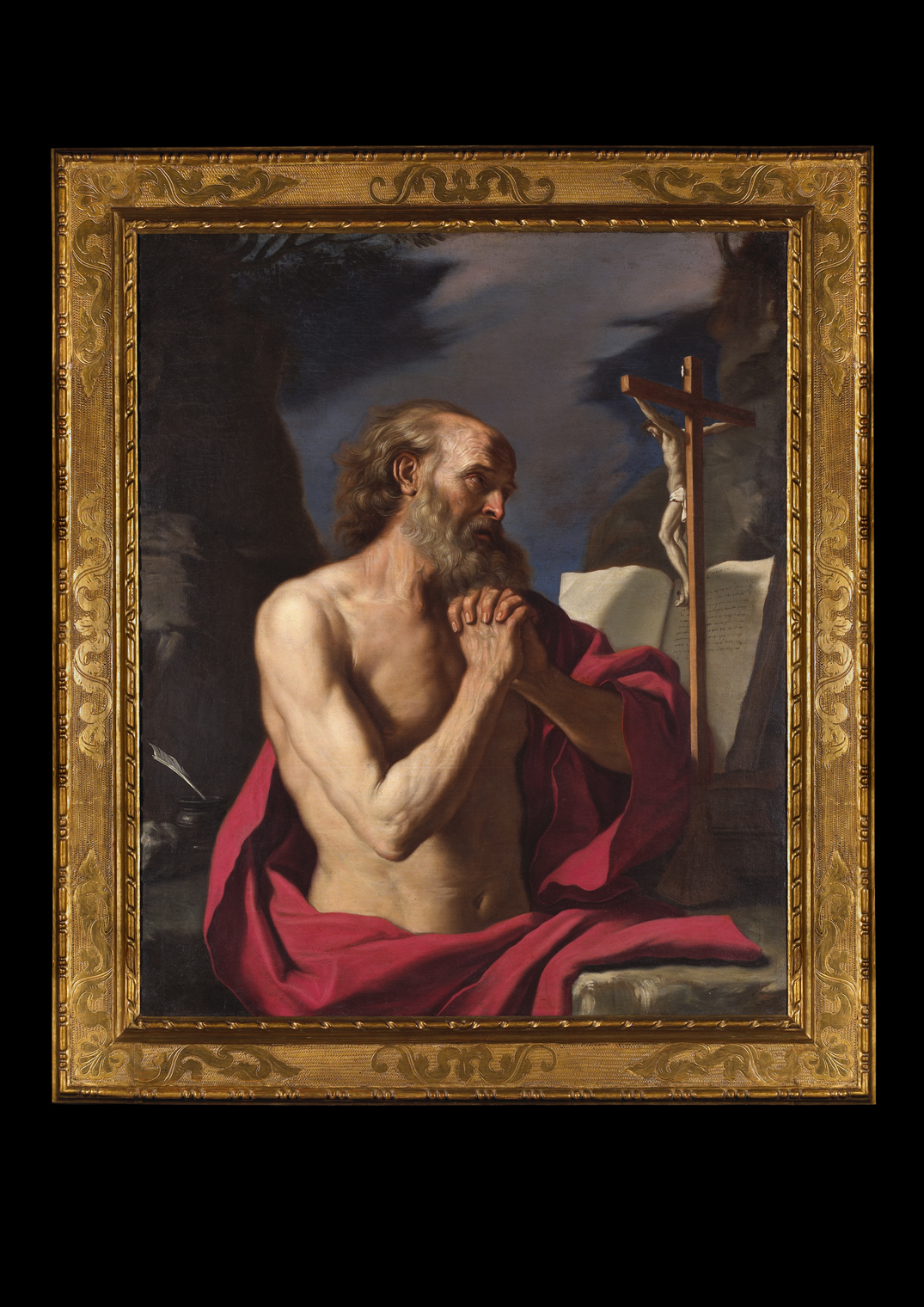
 Facebook
Facebook
 Twitter
Twitter


 Gmail
Gmail
